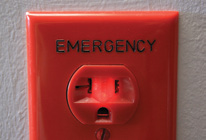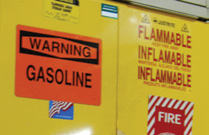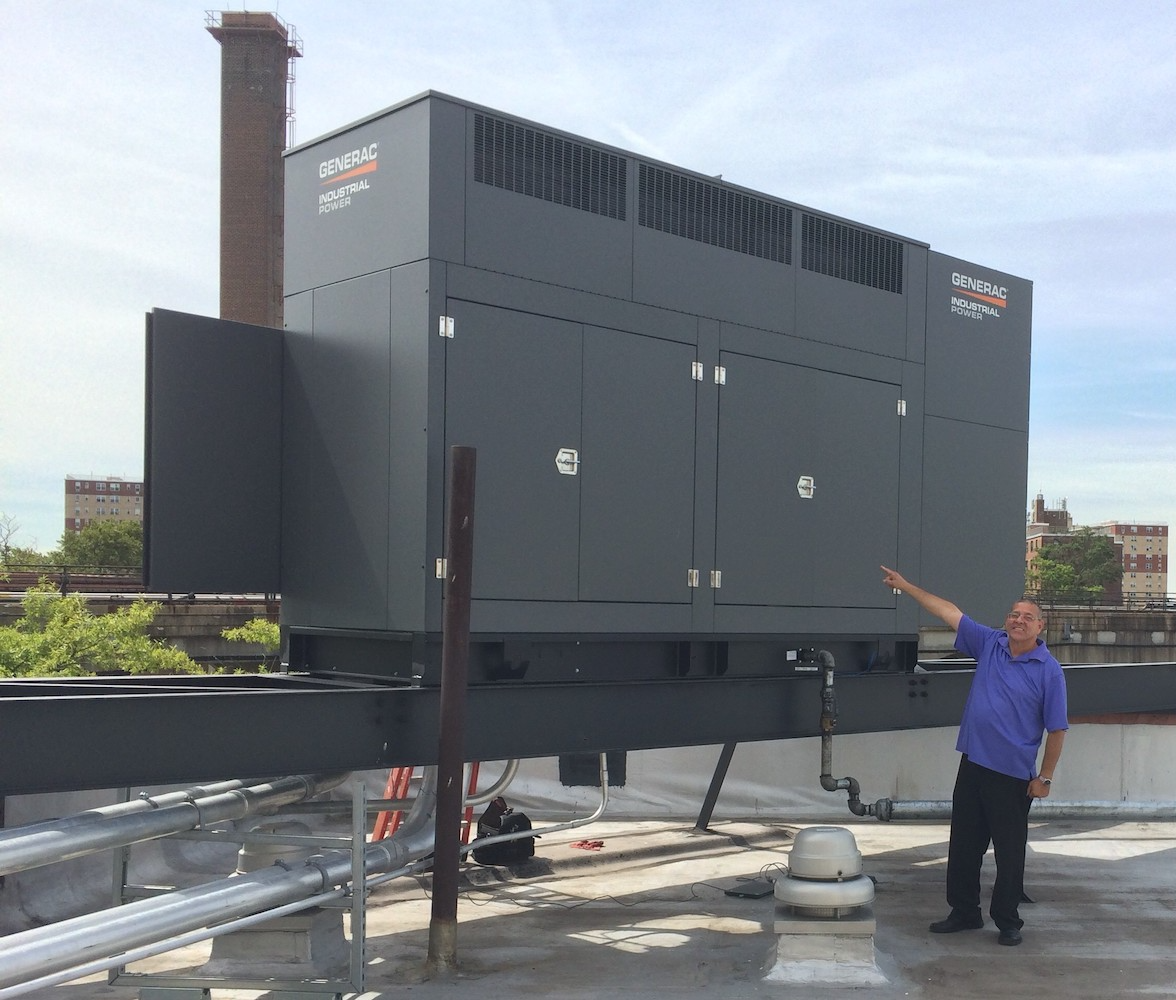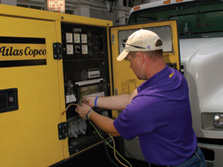Islandable Power.
Description + function
Larger, high-rise residential buildings are typically required to have backup power for critical functions, such as the operation of one elevator and a fire-suppression pump. Smaller buildings are not. Backup power becomes even more necessary if residents are sheltered in place during power outages.
|
|
Some buildings install a permanent exterior connection so it is easy to roll up a temporary generator and plug it into the emergency circuits.
|
Strategy into action

designated for emergency use only.
Consider what systems will be connected to the generator’s emergency circuit. The higher the power needs, the more complex and costly the system must be.
Local codes frequently require that when a generator is installed, it powers emergency lighting, fire-suppression pumps, at least one elevator, at least one sewer ejector and other equipment.
In addition to the minimum requirements, consider adding:
- Emergency outlets to charge cell phones and computers.
- Electronic igniters for gas- or oil-fired heating systems.
- Fans and pumps for heating systems.
- Water-booster pumps to deliver potable water to upper floors.
- Sump pumps.
- Telecom systems.
- Cable modems and wireless routers.
- Alarms and security equipment.
- A central washer and dryer.
Transfer switches.
- When utility power fails it is essential to smoothly and safely switch to emergency power. Most systems include a transfer switch which makes this happen.
Automatic transfer switch (ATS).
- An ATS continuously monitors electric utility power and automatically switches over to emergency power when necessary, then back to normal power.
Manual transfer switch (MTS).
- An MTS must be activated by staff and takes much longer to switch power over than an ATS. Much less expensive than an ATS, an MTS is much more challenging to operate.

Generator systems
There are many types of backup generators, each with advantages and disadvantages. You must consider the needs of your site when selecting an appropriate generator, including the location where it will be installed, fuel storage issues, the amount of emissions it will produce and your budget.
|
|
Gasoline Generators
|
||
|
Storage On-site, usually in small containers. |
Quantity of Emissions Moderate |
Fuel Cost $ |
Special Issues Storage life limited; plan for cycling needed. Highly flammable. Tanks must be anchored. |
|
|
Propane / LPG (Liquified Petroleum Gas)
|
||
|
Storage On-site, in tanks. |
Quantity of Emissions Low |
Fuel Cost $$ |
Special Issues Highly explosive. Tanks must be anchored; larger tanks are usually buried. |
|
|
Natural Gas Generators
|
||
|
Storage Piped to site. |
Quantity of Emissions Low |
Fuel Cost $$ |
Special Issues Gas pipelines may be shut off during disasters to avoid fires. Highly flammable. |
|
|
Diesel Generators
|
||
|
Storage Onsite; must be protected from freezing. |
Quantity of Emissions High |
Fuel Cost $ |
Special Issues Storage life limited; plan for cycling needed. Lower flammability than gasoline. Tanks must be anchored. |
|
|
Biodiesel Generators
|
||
|
Storage Onsite. |
Quantity of Emissions Low |
Fuel Cost $$ |
Special Issues Plan for cycling needed. Lower flammability. Tanks must be anchored. |
|
|
Combined Heat and Power (Cogeneration) Generators
|
||
|
Storage Onsite; various fuel types. |
Quantity of Emissions Low |
Fuel Cost $-$$$ |
Special Issues Extremely fuel-efficient. |
|
|
Battery Storage
|
||
|
Storage On-site; capacity limited. |
Quantity of Emissions None |
Fuel Cost -- |
Special Issues Potential for solar battery charging. |

- Employ only a licensed electrician to install and maintain a backup power system.
- For larger systems, consult an experienced engineer to oversee installation and maintenance.
- Install generators and the systems that support them (transfer switches, fuel pumps, etc.) above the DFE.
- Ensure that your building is able to support the weight.
- Minimize noise and vibration of generators to avoid disturbing residents and neighbors.
Generator Placed Indoors
|
Leaves, snow and other debris do not need to be removed. |
Can cause noise and vibration problems for residents. |
|
In cold climates, heating elements are not required to keep the generator ready. |
Involves structural considerations to make sure the building frame can handle the weight. |
Generator Placed Outdoors.
|
Can be located away from residents to minimize noise and vibration. |
Exhaust can enter building through HVAC systems. |
|
Saves valuable interior space. |
Heating/cooling systems are required to keep the generator ready. |
Operations + maintenance

Develop a maintenance plan that “exercises” the generator regularly and cycles through stored liquid fuel on a defined schedule so you can be sure it will be available and not stale when needed. Train facility staff in equipment operation.
Building codes typically require regular inspection and testing of generators.
Develop a maintenance log protocol, which can be used for manufacturer reimbursement in cases of system failure.
Estimated cost
- $
- $$
- $$$
- $$$$
Supporting strategies
Resources
- Applications of Solar Technology for Catastrophe Response, Claims Management, and Loss Prevention, NREL. www.nrel.gov/docs/fy99osti/25866.pdf
- Combined Heating and Power Acceleration Program, System Catalog, NYSERDA. https://www.nyserda.ny.gov/Funding-Opportunities/Current-Funding-Opportunities
- Emergency Power, Engineering Principles and Practices of Retrofitting Floodprone Residential Structures, Chapter 5, FEMA, January 2012. www.fema.gov/media-library/assets/documents/3001?id=1645
- Siemens Generator Sizing Guide Including Load Calculators. siemens.com/download?BTLV_40983
Background
Built in the early–1900s as a hospital, 318 Beach 85th St., Queens, NY is a 62,000 sq. ft. state-licensed residence operated by Services for the Underserved (SUS). It provides 71 units of supportive housing.
Less than 100 yards from Jamaica Bay, and 50 ft. from the Atlantic Ocean, the building is located within the FEMA AE flood zone, an area subject to inundation during a 100-year flood. After Superstorm Sandy, the first floor was flooded with 4 ft. of water and the building was without power for a month. Residents could not return to their homes for a year.
Strategy
SUS installed a natural gas-fired, 261 kW generator on the roof. The generator is connected to an Automatic Transfer Switch, and is sized to carry the entire electrical load of the building.
Cost
The generator and installation cost about $250,000. Funding came from a Community Development Block Grant, Disaster Recovery (CDBG-DR).









